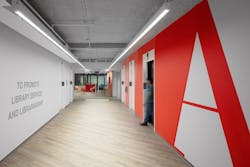American Library Association’s New Chicago Office Tells Its Own Story Through Design
Both employers and employees alike crave workplaces that embody company culture and tell a compelling story of the brand they work for. So, when it came to relocate its long-time office in Chicago, the American Library Association (ALA) tapped design firm NELSON Worldwide to deliver a new space that would excite and motivate staff while leaving a lasting impression on members and visitors.
To develop a deeper understanding of the company culture, the NELSON Worldwide design team worked closely with ALA employees, ultimately determining that the ALA is made up of a kaleidoscope of communities that, like those they serve, celebrate diversity. As a result, the design was driven by the unique collectivism found within the kaleidoscope.
As guests arrive on the 13th floor of the Chicago building where the ALA’s new 55,000-square-foot office is located, they are greeted with a bold graphic that reads: “To Promote Library Service and Librarianship.” This is one of many bookish graphics and signs placed throughout the office that help convey the organization’s ethos and remind visitors of the work the ALA does.
“NELSON designed all of the graphics in the space, from the large, colorful ‘A’ in the elevator lobby that extends into reception, to the text graphics on columns and the custom designed film patterning on the glass walls,” said Kristin Cerutti, design leader and director at Nelson Worldwide.
Adjacent to the elevator lobby is a glass wall that provides a glimpse into the reception area. Inside, a large graphic is stretched out and lined throughout the wall and into the main work area, where it creates a backdrop for some of the organization's previous magazine covers and vintage celebrity READ posters.
Strategically placed right off the reception area is a long corridor that displays award-winning books, more digital monitors with graphics that celebrate ALA, a custom reading nook and a rotating display of the organization's artwork.
“All of these elements were designed to represent the design concept of the kaleidoscope,” explained Cerutti. “[Which is] something that celebrates the beauty of each individual piece, but when brought together is when the entire picture is understood and appreciated. This is similar to how the different divisions within ALA work together to support their members but also represents how their members and their libraries become the element that brings diverse and beautiful communities together.”
Telling a Story with Design
Located in the center of the office is the space’s crown jewel: the main library. The design team made sure this is where the kaleidoscope inspiration shines brightest. It features a plethora of colors—including orange, red and teal—that merge to showcase the diversity in the community.
“The library was intentionally located at the heart (the connection point between the two buildings) of the space. ALA’s previous home was made up of two adjacent buildings, but the convoluted navigation between the two made it almost impossible to stay connected with colleagues,” said Cerutti. “The very intentional selection of the move to 225 N. Michigan meant that they could maintain a little of their past by living, again, in a space spread across two buildings, but instead of that being a hindrance, that is now celebrated by making that connection point the place where all of their teammates can come together.”
[Related: Office Matters, Part 1: Reviving Work at the Office]
Past the library is an open-floor workplace, which was intentionally left neutral so that the focal point rests on the thousands of books housed both in the library and throughout the open office area in bookcases lining walls and workstations. At the beginning of the design process, the change from private offices in the old headquarters to open workspaces was an area of concern. To help ease the transition, NELSON held visioning, imagery and design meetings with the ALA team, as well as partnered with BOS Holdings to create multiple mock-ups of workstation layouts.
“This allowed employees to test out their new desks and give feedback via surveys,” explained Cerutti. “The NELSON team was therefore able to make last-minute adjustments to aspects of the design prior to the official opening. The firm also created a welcome packet for the ALA staff to help them better understand their new space, how to use it effectively and introduce them to the new amenities.”
Located alongside the perimeters of the space, natural daylighting boosts productivity as well as makes the space brighter and more welcoming for staff working in the open workstations. The technology in the workplace also received an upgrade. Webinar rooms were added for the staff to better record and give live CEUs, podcasts and webinars from their office space. A variety of moveable furniture also accommodates more agile work throughout.
“Given that a lot of teammates were moving from private offices to workstations, a number of huddle rooms and phone rooms were added throughout the floor plan to allow people to step away, take personal calls and do focused work,” noted Cerutti.
Ultimately, the new plan made it possible for staff to work in a more open environment through grouped workstations that encourage interaction and collaboration. Those who do have private offices are also made to feel a part of the larger office ecosystem through smaller footprints and glass walls that allow visual connections.
When it comes to designing workplaces that connect a company’s culture to users of the space, Cerutti suggests spending time upfront getting to know the client and not only what they do, but who their clients are.
“What do they offer to their clients and what do they stand for and support?” she asked. “ALA is so much more than books, which is what most people probably think of first. They are a place for children to be safe after school, a place to go to be taught how to write a resume, a place where you can go to vote, etc.—and they are open to anyone, no questions asked. When you truly understand an organization and what they stand for, it becomes much easier to tell a really amazing story.”
Read next: Cooke School & Institute Meets Needs of Students Through Appropriate Architecture and Design
About the Author

Adrian Schley
Associate Editor
Adrian Schley was an Associate Editor for i+s, where she covered the commercial interior design industry since 2018. Her work can also be found in BUILDINGS and Meetings Today.
